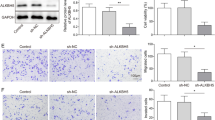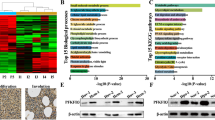Abstract
Alkylation repair homolog protein 5 (ALKBH5) is reported to participate in infantile hemangioma (IH) progression. However, the underlying mechanism of ALKBH5 in IH remains unclear. Using qRT-PCR and Western blotting, ALKBH5, forkhead box F1 (FOXF1) and hexokinase 2 (HK-2) expressions in IH tissues and IH-derived endothelial cells XPTS-1 were assessed. The Me-RIP assay was used to analyze FOXF1 m6A level. CCK8, colony formation, flow cytometry and transwell assays were employed to determine IH cell viability, proliferation, apoptosis, migration and invasion. The interactions between YTH (YT521-B homology) domain 2 (YTHDF2), FOXF1 and HK-2 were analyzed by RIP, dual luciferase reporter gene assay and/or ChIP assay. The in vivo IH growth was evaluated in immunocompromised mice. FOXF1 was overexpressed in IH tissues, and its silencing inhibited IH cell proliferation, migration and invasion whereas promoting cell apoptosis in vitro. ALKBH5 upregulation facilitated FOXF1 mRNA stability and expression in IH cells in a m6A-YTHDF2-dependent manner. FOXF1 downregulation reversed the impact of ALKBH5 upregulation on IH cellular phenotypes. It also turned out that FOXF1 positively regulated HK-2 expression in IH cells through interacting with the HK-2 promoter. HK-2 upregulation abolished FOXF1 knockdown’s inhibition on IH cell aggressive behaviors. ALKBH5 or FOXF1 silencing suppressed IH tumor development via HK-2 signaling in immunocompromised mice. ALKBH5 promoted FOXF1 expression m6A-YTHDF2 dependently, which in turn elevated HK-2 expression, thereby accelerating IH development.







Similar content being viewed by others
Data availability
All data generated or analyzed during this study are included in this article. The datasets used and/or analyzed during the current study are available from the corresponding author on reasonable request.
Abbreviations
- IH:
-
Infantile hemangioma
- HK-2:
-
Hexokinase 2
- FOXF1:
-
Forkhead box F1
- ALKBH5:
-
Alkylation repair homolog protein 5
- m6A:
-
N6-Methyladenosine
- IHC:
-
Immunohistochemistry
- qRT-PCR:
-
Quantitative real-time polymerase chain reaction
- SDS-PAGE:
-
Sodium dodecyl sulfate–polyacrylamide gel electrophoresis
- Me-RIP:
-
Methylated RNA binding protein immunoprecipitation
- SD:
-
Standard deviation
- ANOVA:
-
Analysis of variance
- DMEM:
-
Dulbecco's modified eagle media
References
Solman L, Glover M, Beattie PE, Buckley H, Clark S, Gach JE et al (2018) Oral propranolol in the treatment of proliferating infantile haemangiomas: British society for paediatric dermatology consensus guidelines. Br J Dermatol 179:582–589
Liu C, Zhao Z, Ji Z, Jiang Y, Zheng J (2019) Mir-187-3p enhances propranolol sensitivity of hemangioma stem cells. Cell Struct Funct 44:41–50
Satterfield KR, Chambers CB (2019) Current treatment and management of infantile hemangiomas. Surv Ophthalmol 64:608–618
Pan Y, Ma P, Liu Y, Li W, Shu Y (2018) Multiple functions of m(6)a rna methylation in cancer. J Hematol Oncol 11:48
Zhao H, Xu Y, Xie Y, Zhang L, Gao M, Li S et al (2021) M6a regulators is differently expressed and correlated with immune response of esophageal cancer. Front Cell Dev Biol 9:650023
Guo T, Liu DF, Peng SH, Xu AM (2020) Alkbh5 promotes colon cancer progression by decreasing methylation of the lncrna neat1. Am J Transl Res 12:4542–4549
Shen G, Ren H, Shang Q, Zhao W, Zhang Z, Yu X et al (2020) Foxf1 knockdown promotes bmsc osteogenesis in part by activating the wnt/β-catenin signalling pathway and prevents ovariectomy-induced bone loss. EBioMedicine 52:102626
Wang S, Yan S, Zhu S, Zhao Y, Yan J, Xiao Z et al (2018) Foxf1 induces epithelial-mesenchymal transition in colorectal cancer metastasis by transcriptionally activating snai1. Neoplasia 20:996–1007
Zhang Y, Wang P (2022) Foxf1 was identified as a novel biomarker of infantile hemangioma by weighted coexpression network analysis and differential gene expression analysis. Contrast Media Mol Imaging 2022:8981078
Zhang Y, Ren YJ, Guo LC, Ji C, Hu J, Zhang HH et al (2017) Nucleus accumbens-associated protein-1 promotes glycolysis and survival of hypoxic tumor cells via the hdac4-hif-1α axis. Oncogene 36:4171–4181
Ganapathy-Kanniappan S, Geschwind JF (2013) Tumor glycolysis as a target for cancer therapy: progress and prospects. Mol Cancer 12:152
Yang K, Qiu T, Zhou J, Gong X, Zhang X, Lan Y et al (2023) Blockage of glycolysis by targeting pfkfb3 suppresses the development of infantile hemangioma. J Transl Med 21:85
Ciscato F, Ferrone L, Masgras I, Laquatra C, Rasola A (2021) Hexokinase 2 in cancer: A prima donna playing multiple characters. Int J Mol Sci 22:8
Chen J, Wu D, Dong Z, Chen A, Liu S (2020) The expression and role of glycolysis-associated molecules in infantile hemangioma. Life Sci 259:118215
Wang J, Shao F, Yang Y, Wang W, Yang X, Li R et al (2022) A non-metabolic function of hexokinase 2 in small cell lung cancer: Promotes cancer cell stemness by increasing usp11-mediated cd133 stability. Cancer Commun (Lond, Engl) 42:1008–1027
Fu Y, Dominissini D, Rechavi G, He C (2014) Gene expression regulation mediated through reversible m6a rna methylation. Nat Rev Genet 15:293–306
Cheng M, Sheng L, Gao Q, Xiong Q, Zhang H, Wu M et al (2019) The m(6)a methyltransferase mettl3 promotes bladder cancer progression via aff4/nf-κb/myc signaling network. Oncogene 38:3667–3680
Ensfelder TT, Kurz MQ, Iwan K, Geiger S, Matheisl S, Müller M et al (2018) Alkbh5-induced demethylation of mono- and dimethylated adenosine. Chem Commun (Camb) 54:8591–8593
Zhang J, Guo S, Piao HY, Wang Y, Wu Y, Meng XY et al (2019) Alkbh5 promotes invasion and metastasis of gastric cancer by decreasing methylation of the lncrna neat1. J Physiol Biochem 75:379–389
Chao Y, Shang J, Ji W (2020) Alkbh5-m(6)a-foxm1 signaling axis promotes proliferation and invasion of lung adenocarcinoma cells under intermittent hypoxia. Biochem Biophys Res Commun 521:499–506
Wu CY, Chan CH, Dubey NK, Wei HJ, Lu JH, Chang CC et al (2020) Highly expressed foxf1 inhibit non-small-cell lung cancer growth via inducing tumor suppressor and g1-phase cell-cycle arrest. Int J Mol Sci 21:89
Wendling DS, Lück C, von Schweinitz D, Kappler R (2008) Characteristic overexpression of the forkhead box transcription factor foxf1 in patched-associated tumors. Int J Mol Med 22:787–792
Laé M, Ahn EH, Mercado GE, Chuai S, Edgar M, Pawel BR et al (2007) Global gene expression profiling of pax-fkhr fusion-positive alveolar and pax-fkhr fusion-negative embryonal rhabdomyosarcomas. J Pathol 212:143–151
Lo PK, Lee JS, Chen H, Reisman D, Berger FG, Sukumar S (2013) Cytoplasmic mislocalization of overexpressed foxf1 is associated with the malignancy and metastasis of colorectal adenocarcinomas. Exp Mol Pathol 94:262–269
Yang Z, Cai Z, Yang C, Luo Z, Bao X (2022) Alkbh5 regulates stat3 activity to affect the proliferation and tumorigenicity of osteosarcoma via an m6a-ythdf2-dependent manner. EBioMedicine 80:104019
Guo X, Li K, Jiang W, Hu Y, Xiao W, Huang Y et al (2020) Rna demethylase alkbh5 prevents pancreatic cancer progression by posttranscriptional activation of per1 in an m6a-ythdf2-dependent manner. Mol Cancer 19:91
DeWaal D, Nogueira V, Terry AR, Patra KC, Jeon SM, Guzman G et al (2018) Hexokinase-2 depletion inhibits glycolysis and induces oxidative phosphorylation in hepatocellular carcinoma and sensitizes to metformin. Nat Commun 9:446
Mathupala SP, Ko YH, Pedersen PL (2006) Hexokinase ii: Cancer’s double-edged sword acting as both facilitator and gatekeeper of malignancy when bound to mitochondria. Oncogene 25:4777–4786
Yang L, Yan X, Chen J, Zhan Q, Hua Y, Xu S et al (2021) Hexokinase 2 discerns a novel circulating tumor cell population associated with poor prognosis in lung cancer patients. Proc Nat Acad Sci USA 118:89
Li P, Xiao XE, Xu Q, Guo ZT (2011) establishment of human infancy hemangioma-derived endothelial cell line xpts-1 and animal model of human infancy hemangioma. Chin J Stomatol 46:129–133
Wu ZB, Shi SL, Pan FJ, Li L, Chen HY (2021) Propranolol inhibits infantile hemangioma by regulating the mir-424/vascular endothelial growth factor-a (vegfa) axis. Transl Pediatr 10:1867–1876
Li D, Li P, Guo Z, Wang H, Pan W (2017) Downregulation of mir-382 by propranolol inhibits the progression of infantile hemangioma via the pten-mediated akt/mtor pathway. Int J Mol Med 39:757–763
Funding
This work was supported by Scientific Research Project of Hunan Provincial Health Commission (No.202206023142).
Author information
Authors and Affiliations
Contributions
KP: Conceptualization; Writing-original draft; Methodology; Formal analysis; RPX: Supervision; Validation; FZ: Data curation; YX: Resources; TDM: Investigation; ML: Software; YF: Visualization; CGZ: Project administration; Funding acquisition; Writing-review & editing. KP, RPX, FZ, YX, TDM, ML, YF, CGZ have read and approved the final version of this manuscript to be published.
Corresponding author
Ethics declarations
Conflict of interest
The authors declare that there is no conflict of interest.
Consent for publication
The informed consent was obtained from study participants.
Ethical approval
This study was passed after review of Ethics Committee of Hunan children's Hospital before enrollment of patients and all participants signed informed consent. The animal studies were approved by the Ethics Committee of Hunan children's Hospital.
Additional information
Publisher's Note
Springer Nature remains neutral with regard to jurisdictional claims in published maps and institutional affiliations.
Supplementary Information
Below is the link to the electronic supplementary material.
11010_2024_4936_MOESM1_ESM.tif
The mRNA level of HK-2, GLUT1, PKM2 and LDHA in XPTS-1 cells after shNC or shFOXF1 transfection was detected by qRT-PCR. The data were expressed as mean ± SD. All data was obtained from at least three replicate experiments. *p < 0.05, **p < 0.01. Two group differences was determined using Student’s t test. Supplementary file1 (TIF 934 kb)
Rights and permissions
Springer Nature or its licensor (e.g. a society or other partner) holds exclusive rights to this article under a publishing agreement with the author(s) or other rightsholder(s); author self-archiving of the accepted manuscript version of this article is solely governed by the terms of such publishing agreement and applicable law.
About this article
Cite this article
Peng, K., Xia, RP., Zhao, F. et al. ALKBH5 facilitates the progression of infantile hemangioma by increasing FOXF1 expression in a m6A-YTHDF2 dependent manner to activate HK-2 signaling. Mol Cell Biochem (2024). https://doi.org/10.1007/s11010-024-04936-y
Received:
Accepted:
Published:
DOI: https://doi.org/10.1007/s11010-024-04936-y




